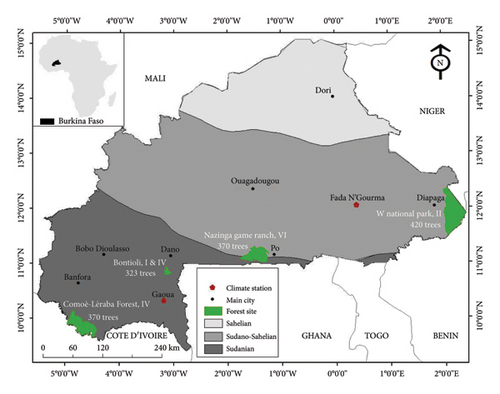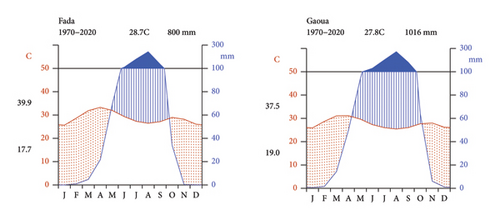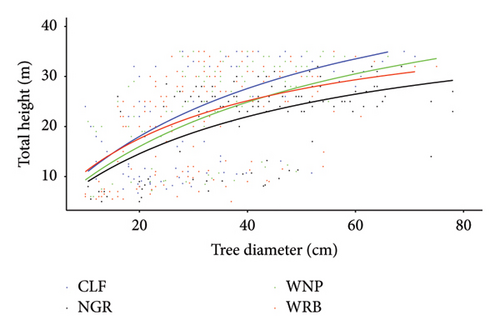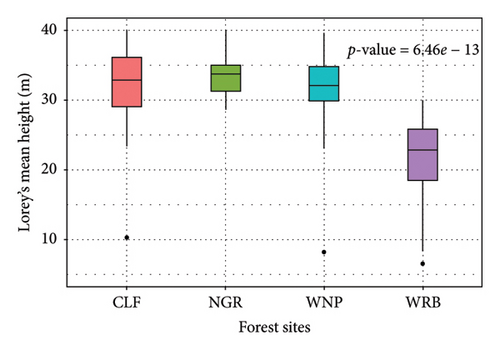Modeling Height–Diameter Allometric Relationships of Dominant African Oak (Afzelia africana Sm) From West African Dry Savannas
Abstract
Tree height is an important ecological parameter for assessing biomass carbon accumulation rate and understanding the ontogenetic development of vascular plants. Given the lack of height measurement data, height–diameter allometric models are needed to improve carbon stock estimates. In this study, we investigated height–diameter relationships of dominant Afzelia africana Sm in West Africa. Using field measurements of 1483 trees across four forest sites and two climatic zones in Burkina Faso, we (i) compared the performance of 10 theoretical models in predicting height–diameter relationships, (ii) tested for site effects on tree height–diameter allometric relationships, and (iii) evaluated the performance of existing regional height–diameter equation in predicting tree height. We found that the asymptotic Gompertz model better described height–diameter allometric relationships of the studied species in the study area. A significant variation of the Lorey’s mean height and the asymptotic maximum height was observed between forest sites, highlighting the variations of height–diameter allometric relationships with site conditions. Existing height–diameter equation developed for West Africa significantly underestimates tree height of A. africana at between 53.34% and 62.63%. The height–diameter allometric models developed in this study can be applied for carbon stock estimates in the semiarid zones of West Africa. Mixed-species height–diameter models integrating other sites and varying climatic conditions can improve biomass estimates and contribute to a better understanding of the drivers of height–diameter relationships in savannas.
1. Introduction
Forest biomass estimates have gained a growing attention across the tropics over the last decade. Tree aboveground biomass (AGB) is usually estimated through allometric models and forest inventory data [1–3]. Biomass allometric equations enable to convert tree size parameters into tree biomass and carbon stocks [2–5]. A review from Henry et al. [2] reported 373 allometric equations developed for biomass estimation throughout tropical sub-Saharan Africa. These equations mostly predicted tree AGB from tree diameter at breast height (DBH) [2, 6–8] and tree height [2, 9–11]. Tree height is primarily an indicator of tree status and forest structure [12] determining light capture, carbon assimilation, and water transport efficiency [13, 14]. Tree vertical structure is an important trait for ecological and physiological strategies of vascular plants [14, 15] reflecting tree hydraulic conductivity [13, 16] and resource distribution throughout the plant [16]. However, unlike for tree diameter, measuring tree height is relatively difficult and time-consuming particularly over a large geographic scale [17–20]. Therefore, tree height is most often predicted from tree diameter [20].
Predicting tree height from diameter has important implications for forest management [20]. Indeed, height–diameter (HD) models are important for describing stand vertical and horizontal structures [12] and for assessing site quality [21, 22], forest stand dynamics [20], tree volume [1, 2], and stand productivity [14, 15]. It is widely agreed that using tree height among biomass predictors significantly reduces biomass estimation errors [1, 9–11, 17, 23]. Therefore, HD models enable accurate estimation of tree AGB where direct height measurements are absent from inventory data [19, 20, 22, 23].
Recent research effort focused on HD modelling in tropical ecosystems across different geographic scales, from the biome scale [1, 13, 23, 24] to the local scale [11, 19, 20, 22, 25–29]. Yet, the ability of pantropical HD equations in predicting tree height and AGB at the local-scale has been debated [19–22]. Indeed, it is agreed that HD relationships significantly vary between species [11, 20], forest sites [29, 30], geographic regions [20, 21, 31], and continents [13]. A recent study reported that pantropical and regional HD models significantly underestimate tree height in the Congo basin [22]. Other studies highlighted species effects on HD relationships [25, 26], emphasizing the use of species-specific HD equations in biomass estimation [22]. By applying these site-specific models, more accurate assessments of tree biomass and carbon stocks can be achieved.
- (i)
To develop HD allometric models for A. africana;
- (ii)
To assess the influence of site conditions on HD allometric relationships;
- (iii)
To evaluate the ability of regional HD model in tree height prediction.
2. Materials and Methods
2.1. Study Area
The study area includes four classified forests (hereafter named forest sites) from Burkina Faso (Figure 1(a)). The sites were W national park (WNP, 11°54′−12°35′N, 1°46′−2°23′E), Nazinga game ranch (NGR, 11°01′−11°18′N, 1°18′−1°43′W), the faunal (or wildlife) reserve of Bontioli (WRB, 10°70′−10°95′N, 3°02′−3°20′W), and the Comoé-Léraba forest (CLF, 9°25′−11°5′N, 5°35′−3°30′W) (Figure 1(a)). The study sites span a broad range of climatic and floristic conditions in West Africa. The WNP and the NGR are characterized by a Sudano-Sahelian climatic condition. The WRB and the CLF belong to the Sudanian climatic zone. The study area has a pronounced dry season that extends from October to April and a short rainy season between May/June and September. Long-term climate records spanning the period 1970–2020 showed a mean annual precipitation of 800 mm year−1 in WNP and 994 mm year−1 in WRB, with a mean annual temperature decreasing from 28.8°C to 27.7°C, respectively (Figure 1(b)). Elevation data obtained from the Shuttle Radar Topography Mission (STRM) digital elevation model (DEM) show that mean altitude varies slightly across the four forest sites with 285 m a.s.l (199–371) at WNP, 330 m a.s.l (241–419) at NGR, 291.5 m a.s.l (240–343) at WRB, and 279.5 m a.s.l (212–347) at CLF. According to the classification of the world database of protected areas (WDPAs) of the International Union for Conservation of Nature (IUCN), the four forests have different ecological status based on their spatial extents and their importance for biodiversity conservation (Table 1).


| WNP | NGR | WRB | CLF | |
|---|---|---|---|---|
| IUCN status | II | VI | I & IV | IV |
| Area (ha) | 235,000 | 91,300 | 42,200 | 125,000 |
| Temperature range (°C) | 25–30 | 25–30 | 20–25 | 20–25 |
| Precipitation range (mm) | 600–900 | 600–900 | 900–1200 | 900–1200 |
| No. of trees | 420 | 370 | 323 | 370 |
| DBH range (cm) | 5–131 | 5–78 | 5–131 | 6–137.5 |
| Mean DBH (cm) | 29.79 | 38.01 | 29.33 | 31.43 |
| SD DBH | 15.01 | 18.34 | 14.48 | 16.88 |
| Height range (m) | 2.5–35 | 2.5–32 | 4–28 | 3–37 |
| Mean height (m) | 21.66 | 19.77 | 19.37 | 21.17 |
| SD height | 10.96 | 9.36 | 10.62 | 9.86 |
- Abbreviations: CLF, Comoé-Léraba forest; DBH, diameter at breast height; NGR, Nazinga game ranch; SD, standard deviation of the mean; WNP, W national park; WRB, wildlife reserve of Bontioli.
2.2. HD Data
Field data on tree height and DBH of A. africana were compiled from two different sources. Forest inventories based on nondestructive sampling were first carried out in the four forest sites using nonpermanent plots. In each forest site, plots measuring 1000 m2 (50 m × 20 m) were installed using a random stratified sampling design. Within each plot, tree height and DBH of all individuals of A. africana with stem diameter greater than 5 cm were measured, using a clinometer and a ribbon, respectively. In total, 1423 trees of A. africana were measured within 144 plots (dataset 1). The second source includes destructive sampling of 60 trees of A. africana harvested in the four forest sites for field biomass estimation (dataset 2). For this second source, 15 trees were sampled per forest site. For the destructive sampling, both tree height and DBH was measured using a ribbon. Tree DBH was measured before tree felling, while tree height was measured from the base to the tip of tree after tree felling. For more details on HD datasets from destructive sampling, see Balima et al. [37]. Overall, 1483 trees with diameter varying 5–137 cm and tree height between 2.5 and 37 m were measured (Figure 1(a) and Table 1).
2.3. Data Analyses
2.3.1. Site-Specific HD Allometric Models
2.3.2. Testing for Site Effects on HD Equations
To assess whether HD allometric relationships vary between forest sites, the asymptotic Gompertz model was applied to the plot-level measurements of tree height and diameter (dataset 1). We computed tree maximum height (Hmax) and Lorey’s mean height (HL) and assessed their variations between forests through a one-way analysis of variance (ANOVA). We further applied the four derivative models described by Loubota Panzou et al. [29] Loubota Panzou et al. [30] to the whole dataset to test for site effects on HD allometric relationships. The R programming software version 4.2.1 [38] was used for the analysis.
2.3.3. Performance of Regional HD Model
The deviations between the observed values and the predicted height values were assessed using the paired t-test. We also computed the relative bias (in %) for each forest site using the sum of the ratio between the mean difference and the measured height values [29].
3. Results
3.1. Site-Specific HD Models
The fitted models showed good fits to HD observations (Supporting Information, Table S2). Among these model functions, the Gompertz model provided the best fits, with the lowest values of AIC and RSE at three out of the four sites. However, the log-linear model, the second-order polynomial of the log-linear model and of the power law model, the monomolecular model, and the Michaelis-Menten model provided better fits at W national park. The asymptotic model was then selected as the best model. Selected HD allometric equations are presented in Table 2. The model goodness-of-fit and output parameters of the selected HD models varied between the four forest sites. The AIC values ranged between 753.9 and 1171, whereas the RSE values varied from 6.01 to 8.28. The graphs of “estimated vs observed heights” and “estimated heights-residuals” are presented as supporting files (Supporting files 3, 4, 5, and 6).
| Forest sites | Goodness-of-fit | Output parameters | |||
|---|---|---|---|---|---|
| AIC | RSE | a | b | c | |
| W national park | 834.6 | 7.25 | 31.8 | 2.64 | 0.0767 |
| Nazinga game ranch | 833.9 | 6.01 | 25.9 | 3.72 | 0.0891 |
| Wildlife reserve of Bontioli | 1171 | 7.94 | 27.1 | 5.06 | 0.1142 |
| Comoé-Léraba forest | 753.9 | 8.28 | 38.1 | 1.46 | 0.0305 |
- Note: a, b, and c: model parameters.
- Abbreviations: AIC, Akaike information criteria; RSE, residual standard error.
3.2. Variations in HD Models
Among the models testing for site effects on HD allometric relationships (Table 3), the model with varying intercept and varying slope was selected as the best model. Through this model, a between-site variation in HD allometric models was observed (Figure 2(a)). The maximum height derived from the site-specific HD equations was lowest in Nazinga game ranch (Hmax = 25.90 m) and highest in CLF (Hmax = 38.12 m). Individuals of A. africana were significantly taller in CLF (Hmax = 38.12 m) and W national park (Hmax = 31.78) compared to Nazinga game ranch (Hmax = 25.90 m) and the wildlife reserve of Bontioli (Hmax = 27.12). Significant differences were also found in Lorey’s mean height between the four forests (Figure 2(b)). The lowest value of Lorey’s mean height was found in the wildlife reserve of Bontioli (21.88a ± 5.96 m), whereas the highest value was observed in CLF (33.89b ± 6.77 m).
| Models | AIC | BIC | p value |
|---|---|---|---|
| General model (null model) | 1171.04 | 1183.51 | |
| Varying intercept and varying slope | 833.88 | 845.32 | 0.012 |
| Varying intercept and fixed slope | 753.94 | 764.59 | 0.001 |
| Fixed intercept and varying slope | 834.61 | 845.82 | 0.045 |
- Note: The best model is shown in bold.
- Abbreviations: AIC, Akaike information criteria; BIC, Bayesian information criterion.


3.3. Performance of Regional HD Models
A significant deviation was found between the observed height values and values predicted from the regional HD allometric model (p value < 2.2e − 16). The regional HD model generated a mean difference of 14.19. Across the four forests, a negative value of the relative bias was found, showing an underestimation of tree height. The values of the relative bias were −53.34% at Nazinga game ranch, −53.89% at Bontioli, −58.45% at W national park, and −62.63% at CLF.
4. Discussion
This study investigated for the very first-time HD allometric relationships of A. africana in West African dry savannas. Through the findings, we found that the Gompertz model outperformed the other fitted theoretical functions at three sites out of the four forest sites. Therefore, this model was selected as the most suitable model describing HD relationships of A. Africana in the study zone. However, the log-linear model, the second-order polynomial (of the log-linear and of the power law model), the monomolecular model and the Michaelis-Menten model also provided good fits to HD data. The variations in the performance of the fitted HD equations were also reported by Fayolle et al. [25] and Kafuti et al. [22]. In fact, a broad range of literature reported linear models (power law and log-linear) as the best function describing HD relationships in the tropics [11, 17, 20, 21, 32, 39, 40]. Linear models imply that tree height should scale with a constant proportion of relative tree diameter [20], following the metabolic ecological theory of tree growth [13, 41]. Other empirical studies showed that fitting asymptotic models such as the three-parameter exponential function [13, 19, 22], the Michaelis-Menten function [25, 29, 31] and the Weibull function [24] reduce the errors and the bias in tree height estimation. Contrary to the linear shape of HD allometric relationships [39, 42], asymptotic model supports a determinate height growth. The suitability of the Gompertz model observed in this study suggests that the vertical growth of A. africana is not continuous but reaches an asymptote that corresponds to tree maximum height. This suggests a saturation of tree height with tree DBH, as also reported on deciduous and semideciduous species [22, 28, 43].
We also found that the intercept and the slope of the Gompertz model varied significantly between the four forests. A significant variation of Lorey’s mean height was found between forests as well. These results suggest intraspecific variations in the pathways in which trees of A. africana from different sites grow up to reach the canopy [44], highlighting a between-site difference in HD allometric relationships [22, 29]. The difference in HD equations among forest sites corroborates several studies conducted across the tropics [1, 13, 18–23, 25, 29, 31, 45]. Our findings imply that for a given diameter of A. africana individual, tree height varied between the four forests, likely as the result of species-specific ecophysiological responses to environmental factors during the ontogenetic development [44]. Therefore, in line other studies, trees of A. africana may have similar growth trajectories across the four forests, but different strategies of resource allocation [29, 46]. The variations in HD equations between forest sites can be explained by differences in the floristic composition [13, 21] and in biotic and edaphic conditions which all affect tree vertical and radial growth [1, 13, 18, 20, 47]. Differences in HD allometric models can be also explained by ontogenetic differences between the four forests [29] since variations in xylem anatomical patterns of the species were also reported in the study region [44]. As such, rainfall differences between the four forests may explain the variations in HD relationships. Indeed, trees from the most humid forest (Comoé-Léraba) had the highest values of maximum height and Lorey’s mean height compared to the driest sites. This result corroborates the fact that higher rainfall (or lower temperature) increases tree growth, tree stature, and forest biomass [48, 49]. The variations between site regarding HD allometric relationships have important implications for the estimation of forest biomass and carbon stocks [1, 23, 25, 27, 31] since differences in biomass allometric equations are attributable to HD and crown–diameter relationships [50].
The findings also showed that existing regional HD model leads to significant underestimates of tree height in the study area. Such errors in height estimation induced by generic HD models were also reported in semideciduous forests of Congo Basin [22] and South African forests [11]. Our result highlights the uncertainties of broad scale allometric equations when applied to the local scale [19–22] and suggests the use of site-specific or species-specific equations to derive tree height and tree biomass [22, 31]. The use of local-scale equations enables to minimize the local-scale variations which are not captured by generic equations [18, 20].
5. Conclusion
This study highlights the limitations of existing regional models for predicting A. africana tree height and emphasizes the need for species- or site-specific equations. The asymptotic Gompertz model proved most effective for height prediction, enabling more accurate biomass and carbon stock assessments. The variations in allometric models across sites underscore the influence of local factors on tree growth. Developed HD models can be applied to estimate tree biomass and carbon stocks when tree height measurements are lacking in inventory data. Extending such studies to other species and regions will further enhance our understanding of tree growth dynamics and improve biomass estimation in West Africa.
Ethics Statement
The authors have nothing to report.
Conflicts of Interest
The authors declare no conflicts of interest.
Author Contributions
L.H.B. designed the study, performed the analysis, and drafted the manuscript; F.O. performed the statistical analysis; B.M.I.N., P.B. and M.G. revised the manuscript; A.T. supervised the work. All authors approved the draft submission.
Funding
This study was financially supported by the German Federal Ministry of Education and Research (BMBF) through West African Science Service Centre on Climate Change and Adapted Land Use (WASCAL) program and the program Climate Research for Alumni and Postdocs in Africa of German Academic Exchange Service (DAAD ClimapAfrica 2021).
Acknowledgments
The authors are grateful to BMBF, DAAD, WASCAL, and GreenGaDe (Greenhouse Gas Determination in West Africa) project. We also thank Prof. Doc. Adeline Fayolle and Doc. Grace Jopaul Loubota Panzou for their support in the statistical analyses.
Supporting Information
Additional supporting information can be found online in the Supporting Information section.
Open Research
Data Availability Statement
The datasets generated during and/or analyzed during the current study are available from the corresponding author on reasonable request.




